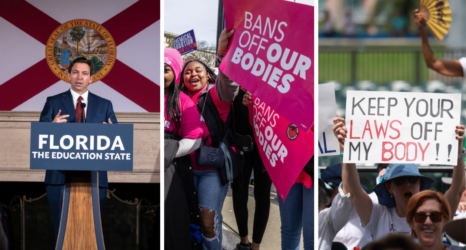Of the many things dividing the United States, none seems more salient than the divide between pro-life and pro-choice forces. At the heart of the dispute is an assumption that, if Roe is reversed and abortion becomes illegal, things will change.
We talk about banning abortion as if we all understand how things will change if abortion becomes a crime. On both sides, we invoke naïve generalities and obsolete references when imagining post-Roe America. The coat hangers, staple features of pro-choice protesters, suggest that women will die if abortion becomes illegal. And the pro-life slogan, “stop abortion now,” seems to assert that making abortion illegal will stop women from having them.
These vague suggestions do not serve us well. Rather, they impede clear thinking about what will happen if states are permitted to make abortion illegal. A variety of legal issues will be set in motion by permitting states to criminalize abortion, many of which arise from the fact that, even without Roe, abortion will remain legal in many states around the country.
After considering how Roe’s demise would alter, but not halt, women’s access to legal abortion in the United States, I turn to the issue of abortion law enforcement. Making abortion a crime is actually more a question than an answer. If abortion is a crime, who are the criminals? As we reflect upon the way in which laws against abortion matter, the experiences of other countries have much to teach us.
Questions of abortion law enforcement are clear: who will we target for punishment, and who will we actually catch? The choices we face, as we look to abortion crimes, are surprisingly obvious, and the consequences are as disturbing as they are predictable.
Judging from how we fight over Roe, you might think that if Roe were overturned, it would be impossible to get a safe, legal abortion in the United States. The truth is otherwise: those with enough time and money will find it easy to obtain a legal abortion, regardless of the laws in their home state. This is because abortion will remain legal in many US states, regardless of the Supreme Court’s position on the matter.
Let me explain. Back in 1972, every state had its own laws about abortion. Most states made it a crime, but included some exceptions, such as in cases where the mother’s life or health was at risk. A few states—New York, Washington, California, and Hawaii—had recently legalized abortion, permitting it for any reason, before viability. Rather than “legalizing” abortion, the Supreme Court’s 1973 decision in Roe effectively told the other forty-six states they needed to do so, too.
Talk about the law making a hard shove! By finding that a woman has a constitutional right to privacy under the Fourteenth Amendment, the court overturned the criminal laws of 46 states. Any decision that reverses Roe must begin with a reconsideration of the scope of the constitutional right to privacy.
Roe v. Wade used the concept of fetal viability as the outer limit on a woman’s right to privacy. A woman has a broad right to abortion, as a matter of her private choice, before the point at which the fetus is viable. If the fetus is not yet capable of living outside the woman’s body, abortion is permissible. If the fetus could survive independently, however, she can no longer abort it.
There was no axiomatic reason for picking viability as the dividing line, though. The court might just as easily have drawn the line earlier or later in pregnancy. And in the absence of Roe, a state might well choose some other cutoff point along the gestational path. Indeed, several states have passed laws banning abortion any time after one can hear a fetal heartbeat. Although these laws cannot currently take effect because Roe still protects a woman’s constitutional right to abortion, they hint at how some states might want to restrict abortion if Roe falls.
Even if the Supreme Court reverses itself and decides that the Constitution no longer protects a woman’s right to abortion, though, it still will need to set limits on how states frame their abortion laws. For example, it is clear that no state could ban abortion completely. No state could force a woman to continue a pregnancy that poses a threat to her life because the Constitution guarantees a woman’s right to life. Unlike in El Salvador, where the country’s constitution declares a right to life from the moment of conception, nothing in our Constitution recognizes an absolute “right to life” for the fetus. And there’s little chance of this changing any time soon: Constitutional amendments are exceptionally hard to pass, requiring approval not just by both houses of Congress, but also ratification by a majority vote in three-quarters of the states in the country.
If the Supreme Court reverses Roe, then, the open question is how far the court will allow states to go. Will it narrow a woman’s privacy right to some earlier point in pregnancy, or will it jettison the privacy right altogether, permitting states to dictate the circumstances under which abortion will be allowed?
It’s worth playing out the tape on the most extreme case, just to see how much it would matter. Let’s imagine that the Supreme Court goes so far as to permit states to ban abortion except when a woman’s life is at risk. How many states would subsequently enact such bans?
When I asked a pro-life Oklahoman state senator what would happen if Roe v. Wade were reversed, he sighed and said, “It will be a bloodbath on the right.” Pro-life communities will be forced to reckon with the disparate views of their constituents, the vast majority of whom want to keep abortion legal in cases of rape, incest and fetal anomaly. If Roe falls, there will be a furious battle over how to frame the crime of abortion.
But not all states will be fighting. Perhaps the most important thing to remember when thinking about America after Roe is that not all states will choose to criminalize abortion. Even without Roe, abortion will remain legal in as many as half the states. This fact often gets lost in the contentious debates over the Supreme Court’s rulings on abortion. In a number of states around the country, the Supreme Court position doesn’t make a difference. Many states are safely pro-choice, with judicial decisions interpreting state constitutions as protecting a woman’s right to privacy, and large majorities favoring legalized abortion.
If Roe v. Wade is reversed, it is clear that the battle over abortion laws will not end. Instead, while pro-life states struggle to determine the scope of laws restricting abortion, elsewhere, abortion will be legal. As a result, it is fair to say that the most significant barrier to abortion, in a world without Roe v. Wade, will be wealth: how much will an abortion cost and how far must one travel in order to get one?
Adapted from Her Body, Our Laws: On the Frontlines of the Abortion War, From El Salvador to Oklahoma by Michelle Oberman (Beacon Press, 2018). Reprinted with permission from Beacon Press.





